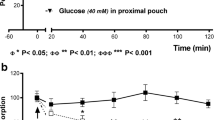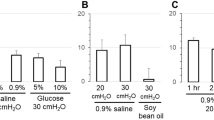Abstract
The effects of various polypeptide enterohormones and the tachykinin secretogogue, physalaemin, on electrolyte transport by the main excretory duct of the mandibular gland of the rabbit were studied in vitro. Vasoactive intestinal peptide (VIP, 2×10−11 mol l−1) and gastric inhibitory polypeptide (GIP, 10−11 mol l−1) reduced nett Na+ movement from lumen to interstitium and VIP also reduced the transepithelial potential difference; the effective concentrations of the two hormones lay within the range of normal plasma concentrations. Gastrin (5×10−7 mol l−1) and synthetic secretin (2×10−7 mol l−1) had similar effects but only at concentrations well above the normal plasma levels. Caerulein, an analogue of the octapeptide of cholecystokinin, had no effect on duct function even at a concentration of 10−6 mol l−1. The potent salivary secretogogue, physalaemin (4×10−8 mol l−1), which is an analogue of SubstanceP, a putative mammalian enterohormone and neurotransmitter substance, caused a marked increase in ductal Na transport (in rat as well as rabbit). It is concluded that VIP and GIP would normally play a role in determining salivary electrolyte composition and it is postulated that their action may be antagonized by a tachykinin such as SubstanceP.
Similar content being viewed by others
References
Barbezat, G. O., Grossman, M. I.: Intestinal secretion: stimulation by peptides. Science174, 422–424 (1971)
Bataille, D., Freychet, P., Rosselin, G.: Interactions of glucagon, gut glucagon, vasoactive intestinal polypeptide and secretin with liver and fat cell plasma membranes: binding to specific sites and stimulation of adenylate cyclase. Endocrinology95, 713–721 (1974)
Bertaccini, G., De Caro, G.: The effect of physalaemin and related polypeptides on salivary secretion. J. Physiol. (Lond.)181, 68–81 (1965)
Bertaccini, G., De Caro, G., Impicciatore, M.: Effects of physalaemin on some exocrine secretions of dogs and rats. J. Physiol. (Lond.)193, 497–511 (1967)
Bloom, S. R., Polak, J. M., Pearse, A. G. E.: Vasoactive intestinal peptide and watery-diarrhoea syndrome. Lancet1973 II, 14–16
Bury, R. W., Mashford, M. L.: Substance P: its pharmacology and physiological roles. Aust. J. Exp. Biol. Med. Sci.55, 671–735 (1977)
Bussjaeger, L. J., Johnson, L. R.: Evidence for hormonal regulation of intestinal absorption by cholecystokinin. Am. J. Physiol.224, 1276–1279 (1973)
Byrnes, D. J., Marjason, J. P.: Radioimmunoassay of secretin in plasma. Horm. Metab. Res.8, 361–365 (1976)
Clendinnen, B. G., Reeder, D. D., Davidson, W. D., Thompson, J. C..: Effect of gastrointestinal hormones on salivation in the dog. Arch. Surg.101, 596–598 (1970)
Coupar, I. M.: Stimulation of sodium and water secretion without inhibition of glucose absorption in the rat jejunum by vasoactive intestinal peptide (VIP). Clin. Exp. Pharmacol. Physiol.3, 615–618 (1976)
Crockett, S. E., Cataland, S., Brown, J. C., Mazzaferri, E. L.: Immunoreactive gastric inhibitory polypeptide levels following oral glucose ingestion. Clin. Res.22, 465A (1974)
Dencker, H., Hakanson, R., Liedberg, G., Norryd, C., Oscarson, J., Rehfeld, J. F., Stadil, F.: Gastrin in portal and peripheral venous blood after feeding in man. Gut14, 856–860 (1973)
Denniss, A. R., Young, J. A.: Studies on the mechanism of action of carbachol and physalaemin on Na+ transport by the perfused rabbit submaxillary main duct. Proc. Aust. Physiol. Pharmacol. Soc.4, 45 (1973)
Denniss, A. R., Young, J. A.: The action of neurotransmitter hormones and cyclic nucleotides and theophylline on electrolyte transport by the excretory duct of the rabbit mandibular gland. Pflügers Arch.357, 77–89 (1975)
Denniss, A. R., Young, J. A.: Action of gastrointestinal hormones on sodium transport across salivary duct epithelium. Clin. Exp. Pharmacol. Physiol.4, 480 (1977)
Desbuquois, B., Laudat, M. H., Laudat, P.: Vasoactive intestinal polypeptide and glucagon: stimulation of adenylate cyclase activity via distinct receptors in liver and fat cell membranes. Biochem. Biophys. Res. Commun.53, 1187–1194 (1973)
Descos, André, F., Lambert, R., André, C.: Influence of secretin on salivary mucous secretion in man. Digestion9, 199–204 (1973)
Dockray, G. J., Hopkins, C. R.: Caerulein secretion by dermal glands inXenopus laevis. J. Cell Biol.64, 724–733 (1975)
Duffy, M. J., Wong, J., Powell, D.: Stimulation of adenylate cyclase activity in different areas of human brain by substance P. Neuropharmacology14, 615–618 (1975)
Emmelin, N., Lenninger, S.: The “direct” effect of physalaemin on salivary gland cells. Br. J. Pharmacol.30, 676–680 (1967)
Erspamer, V., Falconieri Erspamer, G., Linari, G.: Occurrence of tachykinins (physalaemin- or substance P-like peptides) in the amphibian skin and their actions on smooth muscle preparations. In: Substance P (U.S. von Euler, B. Pernow, eds.), pp. 67–74. New York: Raven Press 1977
Field, M. J., Young, J. A.: Kinetics of Na transport in the rat submaxillary main duct perfused in vitro. Pflügers Arch.345, 207–220 (1973)
Gardner, J. D., Peskin, G. W., Cerda, J. J., Brooks, F. P.: Alterations of in vitro fluid and electrolyte absorption by gastrointestinal hormones. Am. J. Surg.113, 57–64 (1967)
Gardner, J. D., Christophe, J., Robberecht, P., Conlon, T. P.: Membrane receptors for VIP and secretin in pancreatic acinar cells. In: Hormonal Receptors in Digestive Tract Physiology (S. Bonfils, P. Fromageot, G. Rosselin, eds.), pp. 227–235. Amsterdam: North Holland 1977
Gingell, J. C., Davies, M. W., Schields, R.: Effect of a synthetic gastrin-like pentapeptide upon the intestinal transport of sodium, potassium, and water. Gut9, 111–116 (1968)
Gregory, R. A.: The gastrointestinal hormones: a review of recent advances. J. Physiol. (Lond.)241, 1–32 (1974)
Grossman, M. I., Adelson, J. W., Rothman, S. S., Brown, J. C., Said, S. I., Lin, T.-M., Chance, R. E., Gerring, E. L., Gregory, H., Glass, G. B. J., Andersson, S., Nasset, E. S., Sasaki, H., Faloona, G. R., Unger, R. H., Creutzfeldt M., Kokas, E., Thompson, J. C.: Candidate hormones of the gut. Gastroenterology67, 730–755 (1974)
Hardcastle, P. T., Eggenton, J.: The effect of acetylcholine on the electrical activity of intestinal epithelial cells. Biochim. Biophys. Acta298, 95–100 (1973)
Hicks, T., Turnberg, L. A.: The influence of secretin on ion transport in the human jejunum. Gut14, 485–490 (1973)
Hökfelt, T., Johansson, O., Kellerth, J.-O., Ljungdahl, Å., Nilsson, G., Nygårds, A., Pernow, B.: Immunohistochemical distribution of Substance P. In: Substance P (U.S. von Euler, B. Pernow, eds.), pp. 117–145. New York: Raven Press 1977
Jorpes, J. E., Mutt, V.: Secretin, Cholecystokinin, Pancreozymin and Gastrin. Berlin-Heidelberg-New York: Springer 1973
Knauf, H.: The isolated salivary duct as a model for electrolyte transport studies. Pflügers Arch.333, 82–94 (1972)
Kuzio, M., Dryburgh, J. R., Malloy, K. M., Brown, J. C.: Radioimmunoassay for gastric inhibitory polypeptide. Gastroenterology66, 357–364 (1974)
Lee, K. Y., Tai, H. H., Chey, W. Y.: Plasma secretin and gastrin responses to a meat meal and duodenal acidification in dogs. Am. J. Physiol.230, 784–789 (1976)
Martin, C. J., Young, J. A.: A microperfusion investigation of the effects of a sympathomimetic and a parasympathomimetic drug on water and electrolyte fluxes in the main duct of the rat submaxillary gland. Pflügers Arch.327, 303–323 (1971)
Martin, C. J., Frömter, E., Gebler, B., Knauf, H., Young, J. A.: The effects of carbachol on water and electrolyte fluxes and transepithelial electrical potential differences of the rabbit submaxillary main duct perfused in vitro. Pflügers Arch.341, 131–142 (1973)
Moritz, M., Finkelstein, G., Meshkinpour, H., Fingerut, J., Lorber, S. H.: Effect of secretin and cholecystokinin on the transport of electrolyte and water in human jejunum. Gastroenterology64, 76–80 (1973)
Putney, J. W.: Muscarinic, alpha-adrenergic and peptide receptors regulate the same calcium influx sites in the parotid gland. J. Physiol. (Lond.)268, 139–149 (1977)
Reeder, D. D., Becker, H. D., Smith, N. J., Rayford, P. L., Thompson, J. C.: Radioimmunoassay of cholecystokinin. Surg. Forum23, 361–362 (1972)
Rhodes, R. A., Tai, H. H., Chey, W. Y.: Observations on plasma secretin levels by radioimmunoassay in response to duodenal acidification and to meat meal in humans. Am. J. Dig. Dis.21, 873–879 (1976)
Rudich, I., Butcher, F. R.: Effect of substance P and eledoisin on K+ efflux, amylase release and cyclic nucleotide levels in slices of rat parotid gland. Biochim. Biophys. Acta444, 704–711 (1976)
Said, S. I., Faloona, G. R.: Elevated plasma and tissue levels of vasoactive intestinal polypeptide in the watery-diarrhea syndrome due to pancreatic, bronchogenic and other tumors. New Engl. J. Med.293, 155–160 (1975)
Sanzenbacher, L. J., Mekhjian, H. S., King, D. R., Zollinger, R. M.: Studies of the potential role of secretin in the islet cell tumor diarrheogenic syndrome. Ann. Surg.176, 394–402 (1972)
Schneyer, L. H.: Sympathetic control of Na, K transport in perfused submaxillary main duct of rat. Am. J. Physiol.230, 341–345 (1976)
Schneyer, L. H.: Parasympathetic control of Na, K transport in perfused submaxillary duct of the rat. Am. J. Physiol.233, F22-F28 (1977)
Schneyer, C. A., Hall, H. D.: Characterization of physalaeminevoked rat saliva and failure of autonomic blocking agents to modify composition. Proc. Soc. Exp. Biol. (N.Y.)127, 1245–1248 (1968)
Schneyer, L. H., Thavornthon, T.: Isoproterenol-induced stimulation of sodium absorption in perfused salivary duct. Am. J. Physiol.224, 136–139 (1973)
Schwartz, C. J., Kimberg, D. V., Sheerin, H. E., Field, M., Said, S. I.: Vasoactive intestinal peptide stimulation of adenylate cyclase and active electrolyte secretion in intestinal mucosa. J. Clin. Invest.54, 536–544 (1974)
Spearman, T. N., Pritchard, E. T.: Potassium release from submandibular salivary glands in vitro. Biochim. Biophys. Acta466, 198–207 (1977)
Stadil, F., Rehfeld, J. F.: Determination of gastrin in serum. An evaluation of the reliability of a radioimmunoassay. Scand. J. Gastroenterol.8, 101–112 (1973)
Studer, R. O., Trazeciak, H., Lergier, W.: Substance P from horse intestine: its isolation, structure, and synthesis. In: Substance P (U.S. von Euler, B. Pernow, eds.) pp. 15–18. New York: Raven Press 1977
Sundler, F., Håkanson, R., Larsson, L.-I., Brodin, E., Nilsson, G.: Substance P in the gut: an immunochemical and immunohistochemical study of its distribution and development. In: Substance P (U.S. von Euler, B. Pernow, eds.), pp. 59–65. New York: Raven Press 1977
Tidball, C. S.: Active chloride transport during intestinal secretion. Am. J. Physiol.200, 309–312 (1961)
Waldman, D. B., Gardner, J. D., Makhlouf, G. M.: Effects of vasoactive intestinal peptide (VIP), secretin and structurally related peptides on colonic transport and adenylate cyclase activity. In: Hormonal Receptors in Digestive Tract Physiology (S. Bonfils, P. Fromageot, G. Rosselin, eds.), pp. 507–508. Amsterdam: North Holland 1977
Young, J. A., Martin, C. J., Asz, M., Weber, F. D.: A microperfusion investigation of bicarbonate secretion by the rat submaxillary gland. The action of a parasympathomimetic drug on electrolyte transport. Pflügers Arch.319, 185–199 (1970)
Author information
Authors and Affiliations
Additional information
Supported by the National Health and Medical Research Council of Australia. One of us (A.R.D.) is indebted to the National heart Foundation of Australia, for award of a Summer Vacation Studentship. Preliminary reports of this work have already been presented to the Australian Physiological Society [13] and the Australian Medical Research Society [15]
Rights and permissions
About this article
Cite this article
Denniss, A.R., Young, J.A. Modification of salivary duct electrolyte transport in rat and rabbit by physalaemin, VIP, GIP and other enterohormones. Pflugers Arch. 376, 73–80 (1978). https://doi.org/10.1007/BF00585250
Received:
Issue Date:
DOI: https://doi.org/10.1007/BF00585250




